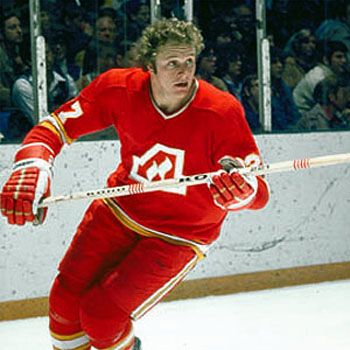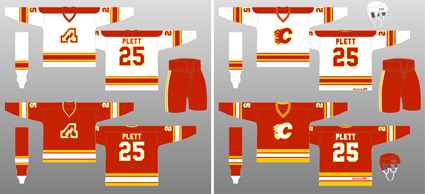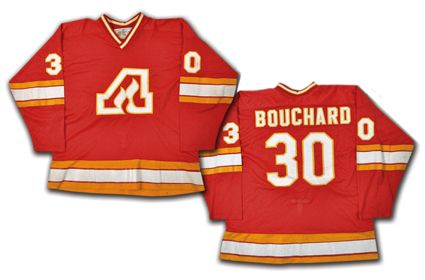It was announced on this date in 1980 that the
Atlanta Flames had been sold to a group of Canadian business men who announced that the franchise would relocate to Calgary, Alberta.
The Flames began play in 1972 as the NHL reacted quickly to occupy the new Nassau Coliseum on Long Island with the New York Islanders in order to prevent the upstart World Hockey Association from moving into the arena. Needing a second team to balance the schedule, Atlanta was also awarded a franchise to occupy The Omni, another brand new arena located in Atlanta, Georgia.
The team was named the "Flames", which originated from the famous burning of Atlanta during the American Civil War.
The Omni seated 15,278 for hockey and was a innovative architectural design with an unusual roof, which looked like an egg crate from the air. It's exterior panels which were designed to rust over to seal themselves shut(!), making a solid structure which would last for decades. The only problem was that the panels never stopped rusting, which eventually created holes in the outer wall so large people were able to sneak into the building for free!
The Omni
The club began with a reasonable start for an expansion team, which included being over .500 as late as mid-January, but a late season swoon saw them finish out of the playoffs at 25-38-15.
Being the only club in the American southeast, the Flames were faced with a difficult travel schedule, as the NHL's divisional alignment at the time defied any geographic logic, as it was still based on the principal of having the Original 6 teams in the East, while the 1967 expansion clubs grouped in the "West".
The additions of Vancouver Canucks and Buffalo Sabres in 1970 and the Islanders and Flames in 1972 further muddied the picture, as Atlanta was grouped with Philadelphia, Pittsburgh, Chicago, Minnesota, St. Louis (closest at 556 miles away), Los Angeles and Oakland, while the "East" division was home to... Vancouver!
The Flames qualified for the playoffs in their second season after a nine point improvement in the standings, although with a sub .500 record of 30-34-14. Highlights that season included the additions of Tom Lysiak who led the club in scoring as a rookie.

While the club improved to a 34-31-15 mark, their 83 points were not enough to make the playoffs. Bright spots were the addition of Eric Vail, who set a club record with 39 goals on his way to the Calder Trophy, and conference realignment, which saw Atlanta now in the Patrick Division (with Philadelphia, the New York Rangers and New York Islanders) of the Campbell Conference (which also included St. Louis, Chicago, Minnesota, Kansas City and Vancouver).
Eric Vail
While the club qualified for the playoffs in 1975-76 and posted their first winning record of 35-33-12, they remained winless in the playoffs, losing 2 games to none in an abbreviated best-of-three series after being swept in four straight by Philadelphia in 1974. The first signs of trouble on the financial front began to surface when their average attendance dropped from a high of 14,162 in 1973-74 to 13,444 then down to 11,963.
The following season of 1976-77 saw the Flames finally win their first playoff game, but were still eliminated in Round 1 by the Kings 2 games to 1. At one point the team was in danger of missing it's payroll in December, and in an emergency campaign, leading city businesses made $750,000 in advance ticket purchases to help the club avoid bankruptcy.
The now familiar pattern began to repeat, as the 1977-78 Flames once more saw a drop in attendance down to 10,501 as they again won 34 games and were eliminated in the opening round of the playoffs in two straight games, this time at the hands of the Red Wings.
A franchise record 90 points in 1978-79 saw a bump in average tickets sold, up to 11,441, but the Maple Leafs took their turn bouncing the Flames from the postseason in the now customary two straight games. While Lysiak was traded to Chicago, Guy Chouinard provided the thrills with the only 50 goal season in Atlanta history.
The 1979-80 season proved to be the Flames last in Atlanta, and yet again it was a predictable season for the club, as they won 35 games, the fifth time in 8 seasons with 34 or 35 wins. They then ended their eight year run in Atlanta with their fifth consecutive (and sixth overall) first round playoff loss, this time 3 games to 1 in the new best-of-five format to the New York Rangers, giving the Flames a combined playoff record of 2-15 in six tries.
With falling ticket sales combined with a rapid rise in player costs, due to the competition for players between the NHL and WHA, the Flames also suffered from the lack of a major television deal.
When an offer to purchase the club came from Nelson Skalbania, former owner of both the Edmonton Oilers and Indianapolis Racers of the WHA, the Atlanta ownership group accepted the deal and Skalbania immediately moved the club to Calgary, Alberta and chose to keep the name "Flames", feeling it reminiscent of the iconic "gas flares" of the oil production industry in Alberta.
The new ownership also retained the Flames jerseys as well, only the flaming "A" logo changing to a flaming "C" for their new home in Calgary.
History now seems on the verge of repeating itself, as the news broke yesterday that the troubled Atlanta Thrashers franchise has been sold to a group who intends to move the club over the border to Winnipeg, Manitoba as the long desired replacement for the beloved Jets, who relocated to Phoenix in 1996.
The latest news as of the time of this writing quotes the mayor of Winnipeg stating the move was just "a matter of time" while fans of the Thrashers have planned a rally today to show their support for their threatened franchise, only the organizer of the event was quoted as saying she expected "several hundred fans to show up", a far cry from the 35,000 who rallied in downtown Winnipeg, donating a reported $13 million to keep the Jets from eventually moving to Phoenix.
While for months it looked as if the Coyotes would be moving back to Winnipeg, the Glendale, Arizona city council's decision on May 10th to subsidize the club with $25 million to keep them in Arizona for the 2011-12 season, set in motion a rapid turn of events which saw the Thrashers become the focus of the potential Winnipeg ownership group.
The Thrashers ownership reports losses of $130 million since 2005 and no longer wish to own the club, located in what is widely regarded as a very poor sports city. With no local ownership proposals having come forward, the team which has been dismal on the ice, qualifying for the playoffs once in 11 seasons (failing to win a single game in the tradition of the Atlanta Flames) and ranked 28th out of 30 in attendance this season seems ripe for the picking.
Will the sale actually happen or is this just another case of someone throwing mud at the wall in an effort to be the first to break the news with little to no repercussions for being wrong? Stay tuned, as those involved are all denying anything and everything, while a majority of the stories allude to a formal announcement of the Thrashers move to Winnipeg on Tuesday the 24th.
Meanwhile the speculation on every other aspect of this story continues to make for good reading, from what will the team be called, how will the NHL's divisional alignment be affected and what will be the fate of the AHL's Manitoba Moose?
Today's featured jersey is a 1978-79 Atlanta Flames Dan Bouchard jersey as worn during Bouchard's finest season of his career when he won 35 games to set a Flames record for most wins in a season. Bouchard split time with Phil Myre for the first five Flames seasons before Myre was dealt to St. Louis, making Bouchard the clear number one goaltender for the Flames final three seasons in Atlanta.
Bouchard never played in less than 34 games, and with the departure of Myre, his totals rose to 58, 64 and 53 before he moved to Calgary when the club was sold and relocated on this date in 1980.
The Flames used the same jersey for each of their eight seasons in Atlanta and it remained intact after the relocation to Calgary, allowing for the obvious change in crest from the flaming A to the flaming C, all the way through the 1994-95 season, a 15 year run for this classic hockey template.
The Calgary Flames pay tribute to their past by using the original Atlanta Flames logo as the A worn to designate their alternate captains.
This jersey was worn without names on the back until 1977-78 when they became mandatory for all NHL jerseys.
Today's video hunt finds us with nothing but brawls to pick from, as the Flames apparently never actually scored any goals if we are to believe youtube.
Note the Philadelphia Flyers reverse nameplates. They had one set made up for TV games and wore them on both the white and orange jerseys, a look they have recently revived.
This next collection of mayhem features the Flames and the Maple Leafs from 1979.
















No comments:
Post a Comment
We welcome and encourage genuine comments and corrections from our readers. Please no spam. It will not be approved and never seen.